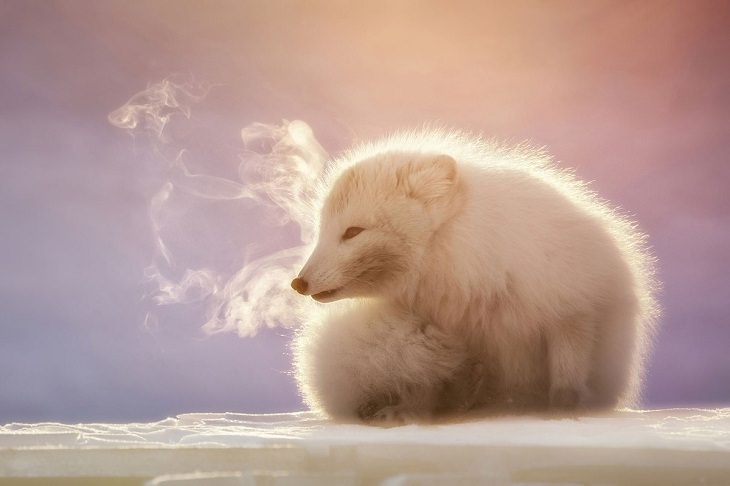The Natural History Museum’s Wildlife Photographer of the Year competition recently launched a 'People's Choice Award' to discover the public's favorite images of the wild. The Wildlife Photographer of the Year competition is a global platform for all photographers where they get a chance to showcase the beauty and diversity of the natural world.
Currently, 25 images of the People’s Choice Award are on display at an exhibition at the Natural History Museum in London until voting ends on February 2, 2022. This year’s entries include a sea of zebras, a female orangutan looking after her baby, an arctic fox breathing out cold air, and a kangaroo and her joey in the middle of a landscape destroyed by fire, among many other jaw-dropping photographs. The overall winning image from the People's Choice Awards will be showcased at the museum until the exhibition closes on June 5, 2022. You, too, can cast your vote on the Natural History Museum’s website.
Here, we have featured some of the best shots from the shortlisted entries so far. These stunning photos show animals at their very best.
Related: 2021 Wildlife Photographer of the Year Winners - 20 Photos
Breath of an Arctic Fox by Marco Gaiotti, Italy
The breath of this little arctic fox in Spitsbergen, Svalbard, was quickly freezing in the air after each call the animal made to one of its partners nearby. It was late winter, and the temperature dropped down to –31 degrees Fahrenheit (–35 degrees Celsius).
Monkey Cuddle by Zhang Qiang, China
Two female Sichuan snub-nosed monkeys huddle with one of the family's youngsters in China's Qinling Mountains.
Life in Black and White by Lucas Bustamante, Ecuador
Dozens of plains zebras gather to drink at Okaukuejo waterhole in Etosha National Park, Namibia.
Hope in a Burned Plantation by Jo-Anne McArthur, Canada
This eastern gray kangaroo and her joey are snapped in the midst of a burned eucalyptus plantation near Mallacoota, southern Australia. The photographer took this picture in early 2020 to document the stories of animals affected by the devastating bushfires that ravaged the states of New South Wales and Victoria.
Stay Close by Maxime Aliaga, France
A female orangutan tries to keep her enthusiastic baby with her in the nest in the Hutan Pinus/Janthoi Nature Reserve of Sumatra, Indonesia.
Lynx Cub Licking by Antonio Liebana Navarro, Spain
An Iberian lynx cub licks its lips as it stares into the lens of the photographer's camera.
Dolphin Hug by Jaime Rojo, Spain
A powerful image of a biologist soothing an Amazon river dolphin in Colombia. These dolphins are extremely tactile and are calmed by direct contact.
The Eagle and the Bear by Jeroen Hoekendijk, The Netherlands
A juvenile bald eagle quietly watches over a sleeping black bear cub in the temperate rainforest of Southeast Alaska, the United States.
All Together by Ly Dang, USA
Baby Clark's grebes hitching a ride on one of their parent's back in San Diego, California.
Shelter From the Rain by Ashleigh McCord, USA
Two male lions share a tender moment during a downpour in the Maasai Mara, Kenya.
Dancing in the Snow by Qiang Guo, China
Two male golden pheasants appear to be performing a unique dance routine in this ethereal shot taken in Shanxi Province, China.
Bonds of Love by Peter Delaney, Ireland / South Africa
A herd of elephants circles to protect their young in Addo Elephant Reserve, South Africa.
The Ice Bear Cometh by Andy Skillen, UK
A female grizzly bear uses a log to cross a stream in Yukon, Canada, in an almost fairytale-like moment.
Hitching a Ride by Wim van den Heever, South Africa
A female giant anteater carries a youngster on her back in the Pantanal wetlands, Brazil.
Jaguar of Ashes by Ernane Junior, Brazil
This jaguar in Brazil’s Pantanal wetlands is covered in ash resulting from fires that swept through the Encontros das Águas State Park in 2020.
Peek-a-Boo by Michiel Van Noppen, the Netherlands
A Baird's tapir peeks out of vegetation in the Braulio Carrillo National Park, Costa Rica. Tapirs are called the “gardeners of the forest" and play a vital role in maintaining the biodiversity of tropical ecosystems. They eat fruits in one place, swallow the seeds, and then walk along. As they move and defecate, they disperse seeds and create genetic diversity between habitats. Unfortunately, due to habitat loss and hunting, there are estimated to be only 6,000 of these precious animals left in the wild.
Living Together by Dhritiman Mukherjee, India
The elusive Satyr tragopan, also known as the crimson horned pheasant, snapped in a village near Punakha, Bhutan. A large pheasant-like bird, this rare beauty is found in the Himalayan reaches of India, Tibet, Nepal, and Bhutan.
Share these beautiful photos with other nature lovers!

